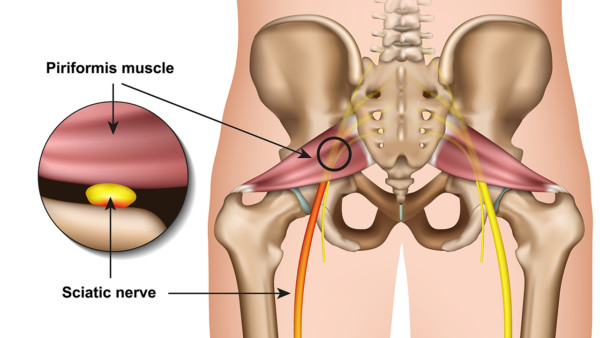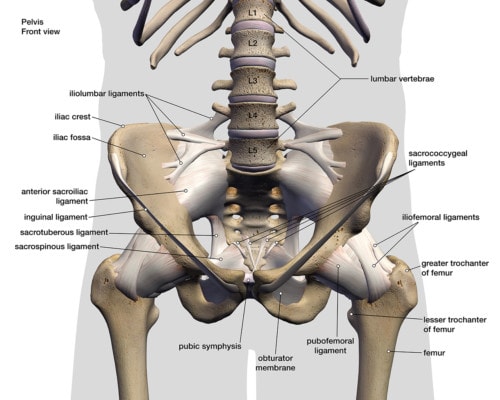Piriformis Injection: What Your Doctor Won’t Tell You
It’s hard for both physicians and patients alike to understand the intense complexity of the connected body. It’s easier to come up with a description for one part that hurts and call it good. I call this “parting it out,” and this is definitely the case with a piriformis injection. Even though there are likely other reasons the piriformis is a problem, our “easy fix” medical care system loves an easy-to-understand label.
The Traditional Piriformis Story

Medicalstocks/Shutterstock
The piriformis is a muscle that goes from the front of the tailbone to the outside of the hip. See the image to the right. The sciatic nerve in some patients can go through the muscle; in most others, it exits in front of and below the muscle. The sciatic nerve is one of the major nerve bundles that’s made up of a collection of spinal nerves from the low back and supplies the muscles in the leg. When the sciatic nerve is irritated by the piriformis muscle, the foot or leg can go numb or the muscles it supplies can develop pain and problems. Other times patients just develop a “pain in the butt” where the piriformis nerve travels.
The Traditional Therapy Based on the Traditional Theory
If the piriformis muscle is tight and that’s causing pain in the muscle/tendon or irritating the nerve, then you need to stretch the muscle. Many different piriformis stretches have been described. To the right is the most common. You lie on your back and hook the foot on the side with the tight piriformis around the opposite knee and then pull that leg back, creating a stretch in the butt area.

Bus109/Shutterstock
A common piriformis injection therapy is steroid anti-inflammatories into the piriformis area, either blind or under ultrasound or fluoroscopic guidance. Finally, if none of that works, shockwave therapy may be tried. The idea here is to cause irritation in the muscle to try and kick off a healing response. Botox is another common piriformis injection concept. The idea here is that the Botox will temporarily relax the muscle. Finally, yet another piriformis injection strategy is platelet rich plasma (PRP). The idea here is that the growth factors in the PRP will help heal the damaged muscle and tendon.
If all else fails, some surgeons cut the muscle to try to free the nerve. This is a highly invasive treatment that obviously can have serious side effects. In addition, it destroys the normal biomechanics of the sacrum and SI joint.
However, none of these therapies answer a critical question. Why is the muscle tight in the first place? Let’s explore that idea.
What Does the Piriformis Muscle Do, and What Could Cause It to Be Tight?
Let’s first look at what we know from MRI research about the piriformis muscle. In one large MRI study, 86% of the patients had either an enlarged muscle or tendinopathy in the muscle tendon (tendon damage). Only about one in four patients had evidence that the sciatic nerve was involved. So what could make the muscle enlarged or beat up?
We’ve known since the ’90s that the piriformis muscle along with many ligaments are involved in stabilizing the sacroiliac (SI) joint. The SI joint lives between the tailbone and the back of the pelvis, so it makes sense that any muscle attached to the tailbone could have a role in stabilizing the joint. The joint is also stabilized by thick and extensive ligaments (see image to the left).

Hank Grebe/Shutterstock
What would happen to the piriformis muscle if the SI joint ligaments were loose? It would go into overdrive to try and stabilize the sacrum (tailbone). This would explain why the piriformis is chronically tight, which in turn causes the muscle to get bigger and beat up.
What Nobody Has Ever Told You About Piriformis Syndrome
So if the cause of the big and torn-up piriformis muscle is an unstable SI joint, why would we treat the muscle? That’s like trying to fix a torn-up tire that got that way because the lug nuts on the rim were loose by focusing on the tire. That approach makes no common sense. In fact, it makes more sense to tighten the lug nuts first and then repair the tire.
So how do you tighten the lug nuts here? You can inject a number of substances to tighten the SI joint ligaments. This can be something as simple as prolotherapy or orthobiologics, like platelet rich plasma or bone marrow stem cells. These are precise fluoro- or ultrasound-guided injections directly into specific ligaments.
The upshot? Always ask yourself why is this happening? Regrettably, most of medicine is focused only on the symptoms and thus only understanding a small part of the whole disease. This happens every day with piriformis syndrome. So why is the piriformis tight? It’s usually instability in the sacrum where the muscle is attached. Hence, if you fix the instability and the muscle, you get a more permanent fix that doesn’t destroy the normal biomechanics.

NOTE: This blog post provides general information to help the reader better understand regenerative medicine, musculoskeletal health, and related subjects. All content provided in this blog, website, or any linked materials, including text, graphics, images, patient profiles, outcomes, and information, are not intended and should not be considered or used as a substitute for medical advice, diagnosis, or treatment. Please always consult with a professional and certified healthcare provider to discuss if a treatment is right for you.
